
Fish Story Time – Black Salmon and Springers
Fishing Friends – With the MSA US winter fund raising season behind us – and thanks to many of you it was a great success – we turn our thoughts to salmon fishing. Some of the world’s earliest fresh run Atlantic salmon fishing is in the UK, and the northern and eastern coasts of Scotland in particular. I got an e-mail recently from Michael Wigan of the Helmsdale – he spoke at our MSA dinner in Falmouth, Maine earlier in the month. Michael said that the while the Helmsdale anglers had yet to catch a springer, that the neighboring Brora and the Naver had already produced their first fish. Another nearby river known for early run “springers” the Thurso, is still waiting for theirs too. I’ll be on the Naver starting Monday March 5, and I’ve been sharpening my hooks.
News Flash – Whilst I’m writing this the “Heron of the Thurso” Pat Nicol just e-mailed me that the first fish came off the Helmsdale this morning. It was taken on the Salscraggie Boils on beat 1 by well-known, local angler Andy Sutherland, brother of the famous fly tier.
Even though all of Scotland and Ireland are far north of New Brunswick’s latitude, the winter weather there is milder. Thanks to a flow of warmer water from the Mediterranean called the “north Atlantic drift” their winters are tempered. Yes, it gets down to freezing, and yes it snows, but right now the daily lows are generally in the high 30Fs and the daily highs are in the mid to high 40Fs. That is about where we will be in early April. The funny thing is, though, that they won’t be much warmer than they are now. By May New Brunswick will be warmer than Scotland, and during the Miramichi summer we are on average a lot warmer both day and night. This makes the Scottish early season water temperatures warmer than ours, and their summer temperatures cooler, and that requires some adjustment by Americans in terms of fishing techniques.

I’ve been using essentially this line only – but with different tips – for my springer fishing over the last 10 seasons. The darker the color of the tip the heavier the sink density.
Virtually everyone fishing in Scotland right now and for the next 60 days will be using some sort of sinking tip. This may only be an intermediate, though it is more often one or two sink speeds faster than that. In addition almost all the flies being fished are metal tube flies. Some folks will go all the way up to materials like tungsten, but most are tied on thin-walled copper tubes. Even on a floating line these flies will swing across the current several inches deep in the water. How does this relate to our early fishing?
By mid-May some of the Gaspe Rivers have a handful of bright salmon, but our first North American fishing in April is all on kelts or winter-over salmon. Unlike the new arrivals, these kelts are dropping down the river and feeding as they go. Everything they will be eating will be located down near the bottom, out of the worst of the current. While I have read that kelts dropping down the river spend most of their time in the top 1 meter of the water column, you will seldom catch one there. They may travel downstream high up in the water, but when they are holding, as they do along the shallow edges of the river, they are near the bottom, out of the strongest flow. Many times while fishing for kelts on the Miramichi I have been day-dreaming between casts with a fly dangling in water off the stern of the boat, and a salmon has swum up to the surface and taken the fly. But for every one that you catch that way, 20 will take a fly swum very slowly, close to the bottom, on the fastest sink tip that you can find.
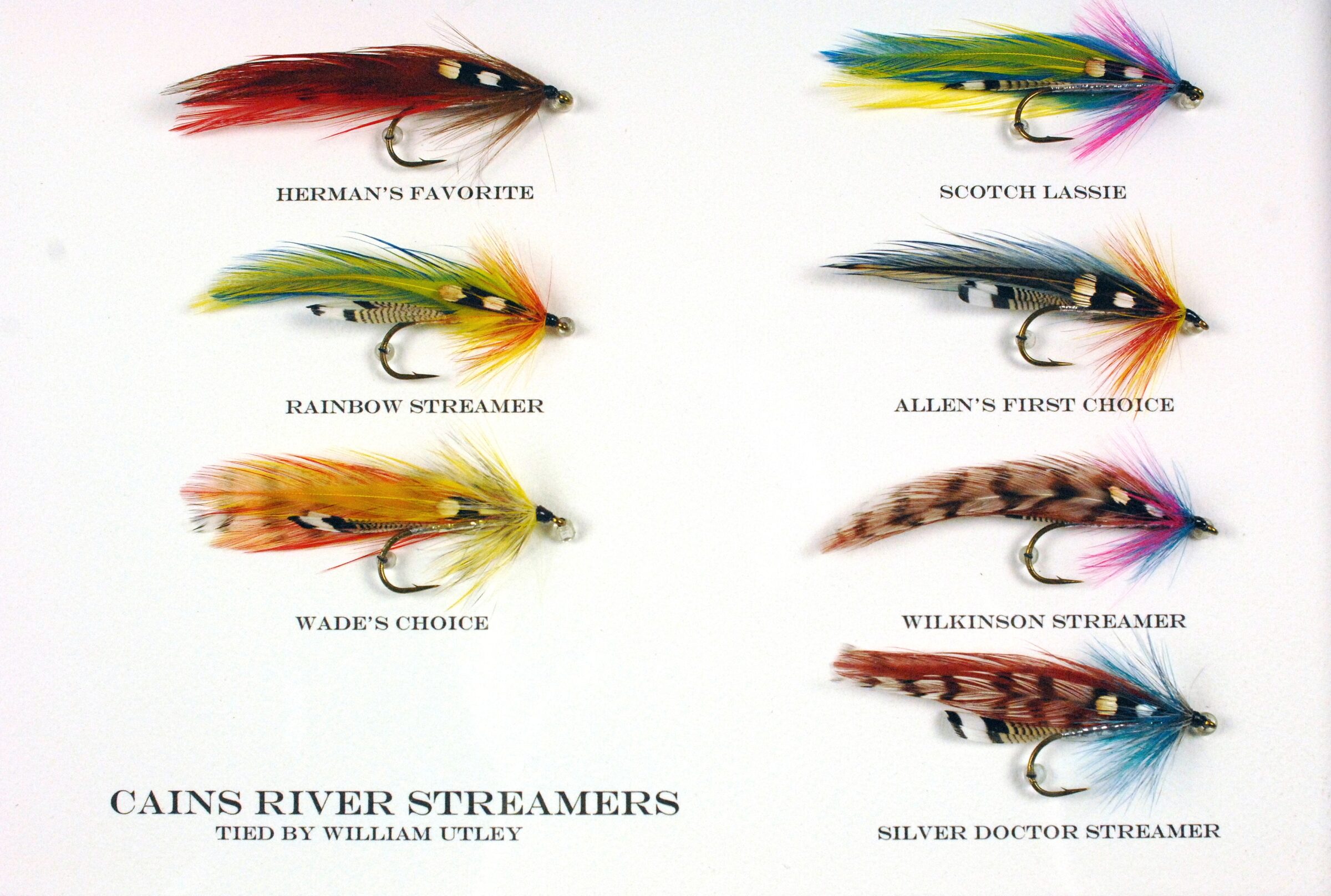
These Cains River streamer patterns are a trip back in time. They were designed for spring salmon fishing. Some of the patterns were named after famous Miramichi guides with names like Wade and Allen, others were old English patterns like the Silver Doctor. They would all work very well today just as they did 100 years ago. Photo by Ralph Vitale for book On the Cains.
With more than 25 seasons of fishing for kelts under my belt, how has this experience modified my technique? As a more energetic, younger angler I thought it was important to keep firing out the casts. I would throw out quite a long cast, mend the line as much as possible, and try to slowly and deeply swing the fly across the current. Then, I would strip off another couple of feet, strip in, and then do it all over again. I do still do some of that as a plan to cover water, but I do it all much more slowly today than I used to. When the fly swings in back of the boat I will just hold it in the current for a
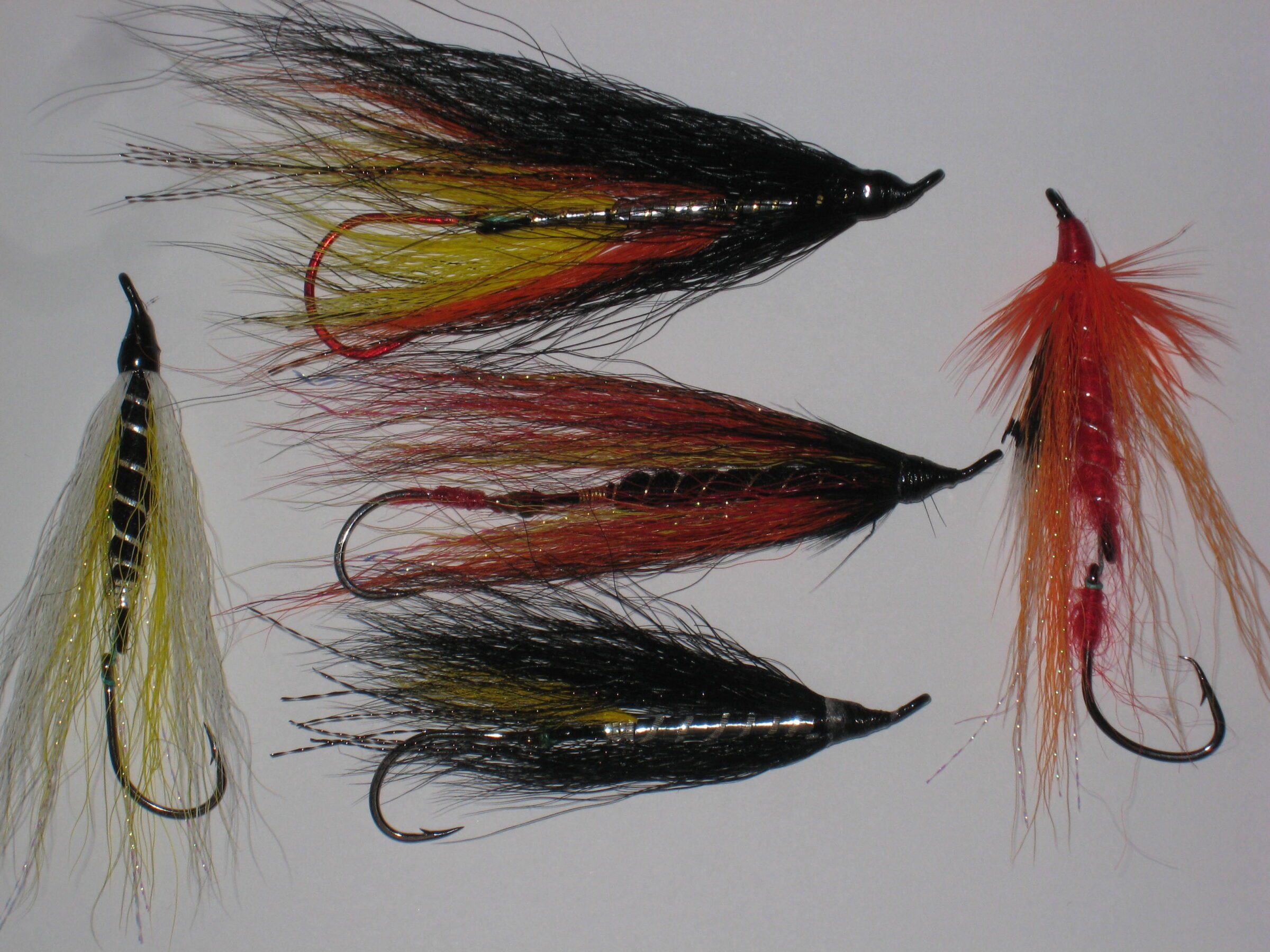
These long, wiggly things tied on Waddington shanks are my favorite spring flies. The barbs need to be crushed before fishing.
few seconds. If I have been getting hits and think I’m in a fishy spot, I’ll even pull off my line for the next cast, and let the fly drift back with the current. After the line comes tight, I’ll again hold it for a while, and then slowly pump the rod a bit. An angler can, just sit there with a fly deep in the water behind the boat and wait. If there are kelts around they will find that fly and hit it. The secret to repetitive success is a large wiggly fly. Almost any fly will do, but a big marabou streamer, or a bucktail like a Mickey Finn is hard to beat when fished deep on a sink tip and moved very slowly.
Many of the local guides use a technique scoffed at by fly fishing aficionados called long-lining. With long-lining there is no cast. The line is simply let far out behind the boat. Once the fly line and large amount of backing is hanging down stream from the boat, the angler painstakingly slowly reels it back in, pausing randomly along the way. It may not fulfill the anglers self-image of heaving 100-foot hero casts across the river, but by god is it ever successful.
Kelts are all well and good, but the real game are the “springers” or early bright run fish. The fishing for them in the Miramichi really gets going in June, but there are some there in May also. Those who put the time in catch them, as evidenced by the regular success of Miramichi guides like Colin Gilks, Rodney Colford and Jason Curtis who have each caught a number of bright May salmon.
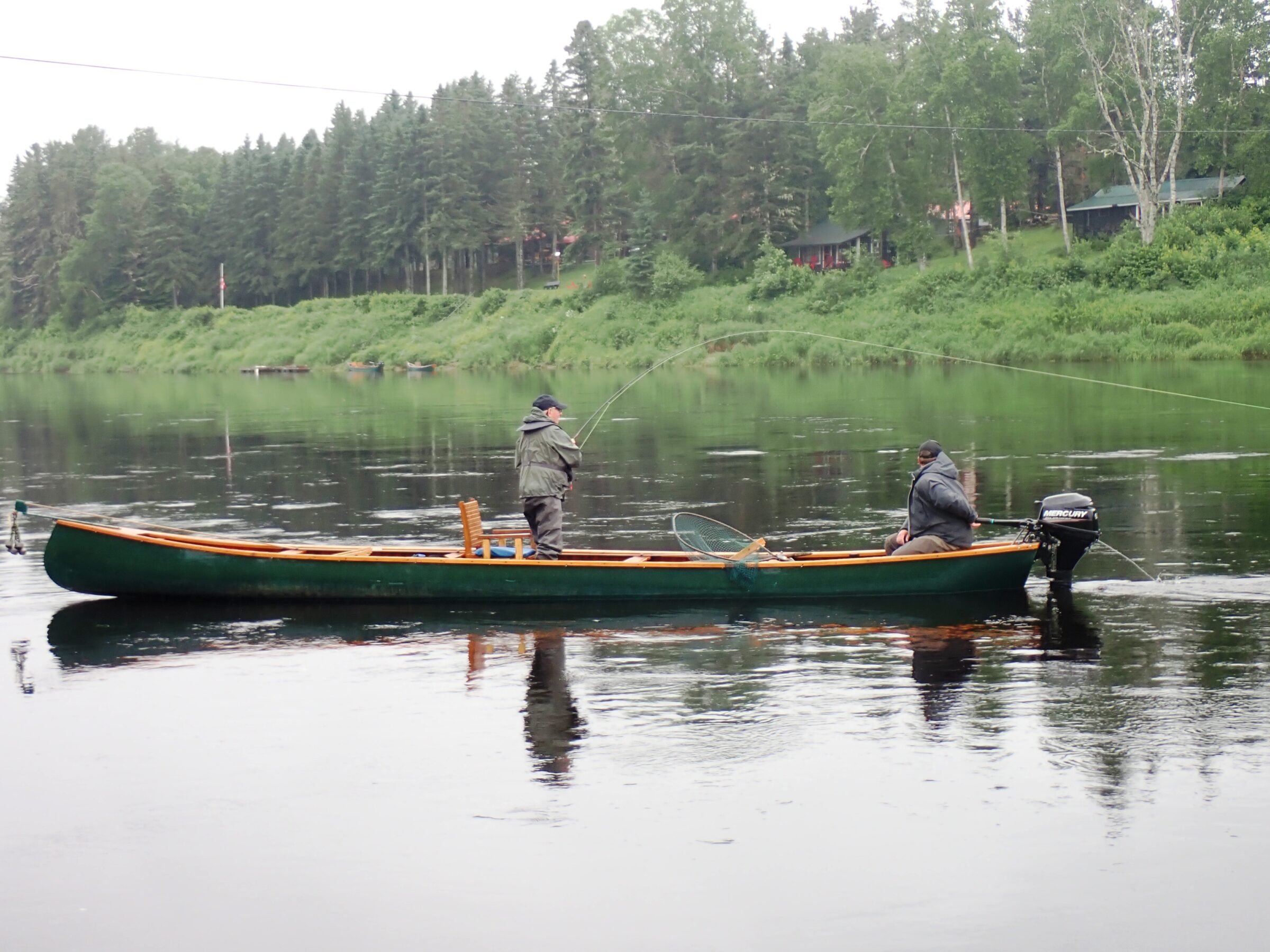
Angler Jim Graul heads to shore at Campbell’s with a 2023 June salmon on the line. Much of the early fishing is best done from a canoe. Guide Tyler Coughlan was borrowed from Country Haven for the day.
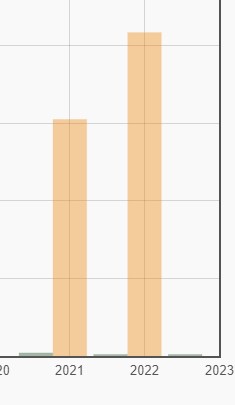
You can barely make out the low green columns for the DFO count to May 31 compared to full season counts.
What makes these early run salmon so special? First, the water is still cold. Late May water in the Miramichi will normally be in the high 40s to low 50s. That cold water is filled with oxygen. Second, the fish are right out of the ocean, and are only days away from having been aggressively feeding. By late June water can be lower and warmer, and fish may take their time leaving the estuary for their run up the river. Not to say that June and even early July salmon aren’t stupendous creatures – they are – but a fish in late May is guaranteed to be the cream of the crop. So why isn’t more May fishing done in the Miramichi for bright fish? Well, there is no question that the run in May is just beginning, and the numbers are less than even in mid-June. All you have to do is look at the early summer numbers at the DFO traps in Millerton and Casillas. The earliest report is May 31, but the percentage of the annual run that is in by that date is less than 1% of what it will eventually be. Incidentally, speaking of Casillas, the NW Miramichi branch, which has been the most devastated by DFO’s mismanagement of striped bass, is known for a slightly earlier run than the SW branch.
Jason Curtis used to say, that any time beginning the third week in May it was worth it to put in your time. That is true if you live near the river and can just go down for an hour or two before or after work. But for most anglers there is a limited amount of fishing time available during a season, and they’d rather invest it when there are more fish around. I guess you can’t blame them for that, but having experienced one great May trip back in 2011, when I caught my only May Miramichi springer, I can tell you it was an experience that was really worth what it took to make it happen.
Should you fish for May and June Miramichi springers any differently than you fish later in the summer? Not much would be my answer. I have fishing friends on the Miramichi who are almost always fishing intermediate tips with their wet flies. They have more confidence in flies fished like that. I have definitely seen fall fishing when a fly fished on a sink tip would regularly be taken, but one fished on a long, tapered mono leader got very few strikes. When we are talking about fishing a pool holding a number of fish on lies during late June or July with water getting up into the mid to high 60Fs, I don’t believe it makes any difference at all. And frankly I much prefer to cast and fish with a mono leader than I do a tip or poly leader. If the water is below the low 60Fs, though, I’d go with the intermediate tip.
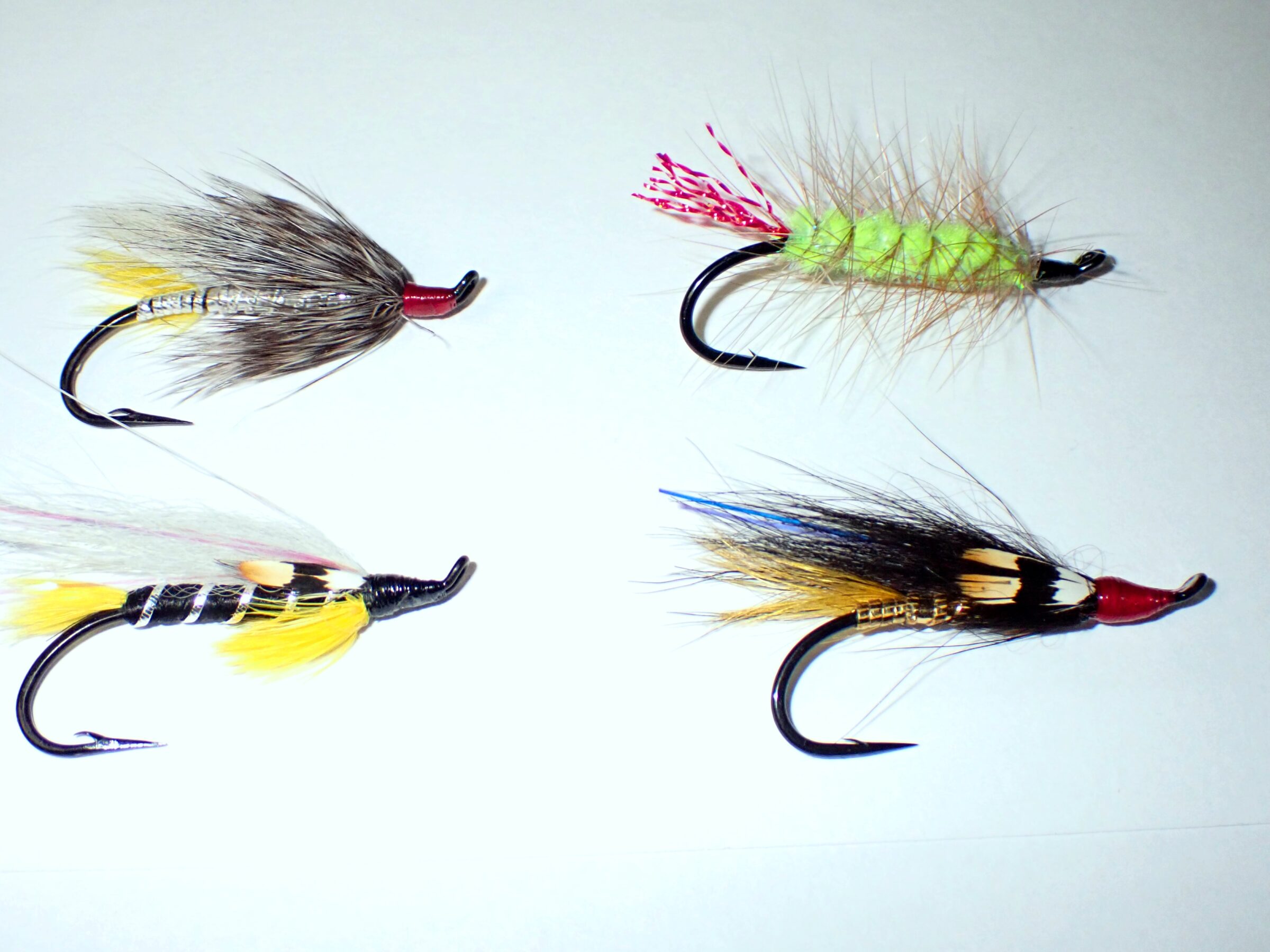
My favorite May/June Miramichi patterns. Clockwise, Silver Rat, Crystal Yum Yum, Black Ghost, John Olin.
I believe that the size of the fly is largely a function of water temperature. The largest fly I use for salmon is a #2. When I look at flies like 1/0, 2/0 or 3/0 they just look too much like gaffs to me. I suppose that if you just hook the fish somewhere in the lip there isn’t much damage, but those really big hooks make an awful hole, and depending exactly where they contact the fish, the really wide gap can hook can penetrate deeply into some vital areas.
Are there any special patterns for those early fish? The rule of thumb among many Scottish anglers is that when the water gets above 55F they go away from the long flies and back to what we think of as standard, salmon wet fly structure. I see these early fish as fresh from ocean feeding. I therefore vary my offerings between flies that I see as having bright ocean colors and traditional dark Miramichi patterns but tied with some flash. For instance, I like a Silver Rat with several pieces of flashabou in the wing. In a size #2 this fly is a little over 2 inches long. Another early bright salmon favorite is a fly I developed that the Black Brook anglers call the Crystal Yum Yum. This fly is a green machine tied on a #2 salmon iron – I have also tied them on streamer hooks – but instead of spinning bucktail I use variegated, flash chenille, and for the tail I use krystal flash tied in one piece at a time to keep it from clumping up. The color is chartreuse. As they say in Chesapeake Bay striper fishing, where the water is often turbid as it is in the early-season, lower Miramichi “If it ain’t chartreuse, it ain’t no use.”
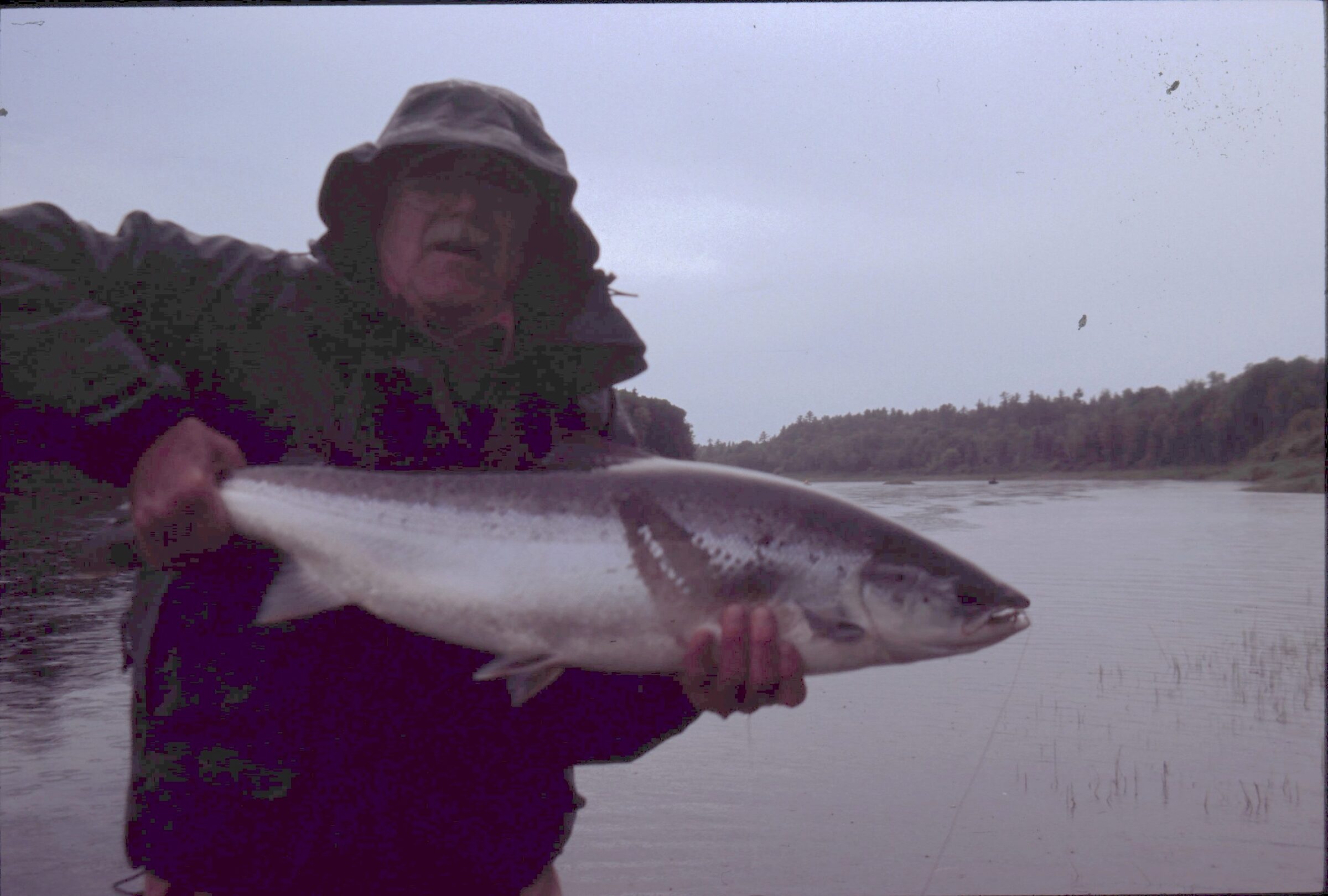
One of those three blockbuster, early June salmon from that mean day in 2005. Willy looks like a medieval priest about to be sacrificing a salmon to the weather gods. What a profile that fish had – all muscle. I thought we’d never land it.
I remember one mid-June day in the very early 2000s when Willy Bacso and I sat on the bench at Campbell’s. Willy was shivering as he complained about the 49F air temperature. It was almost as dark as night, and showers of rain were sweeping over the pool. We had rolled fish out there this morning, though, and nothing short of death would keep me off the river. Use a Black Ghost said Willy, the biggest one you’ve got, like we would use for black salmon. I got three that afternoon and hooked and rose a couple more. The biggest was around 20 pounds. I was fishing alone in my little 22’ Chestnut, and I ended up running it down river to Anderson’s Point where Willy netted them all. All the flies were fished on a 12 pound-test mono leader.
So what is the prognosis for 2024? It’s good, I hope! There has definitely been an early trend in recent years, it is my opinion that it’s in large part because of the consistently strong flows of water, that more of the run is coming in during the first half of the season than it did a few years back. I know that in 2023 the June fishing wasn’t easy because the water was high all the time. But the fish were there. I got to camp on June 9, and encountered salmon every day on the river, though I didn’t put one in the net until the 15th. No matter, I very much enjoyed the fact that they were there, and I was fishing for them.
Willy Bacso would say that “If you don’t count the rest of February, then opening day is only a month a half away.” Then he would always add that “A man has to believe in something… I believe I’ll go fishing.”
Perhaps I should leave it at that pleasant talk about fish. But I can’t help but pass on this message from Scottish salmon fishing personality Ian Gordon’s latest Speyonline blog. In this blog Ian asks his readership that if they had the money to move the needle on the salmon situation, what was the remedy that they would favor?
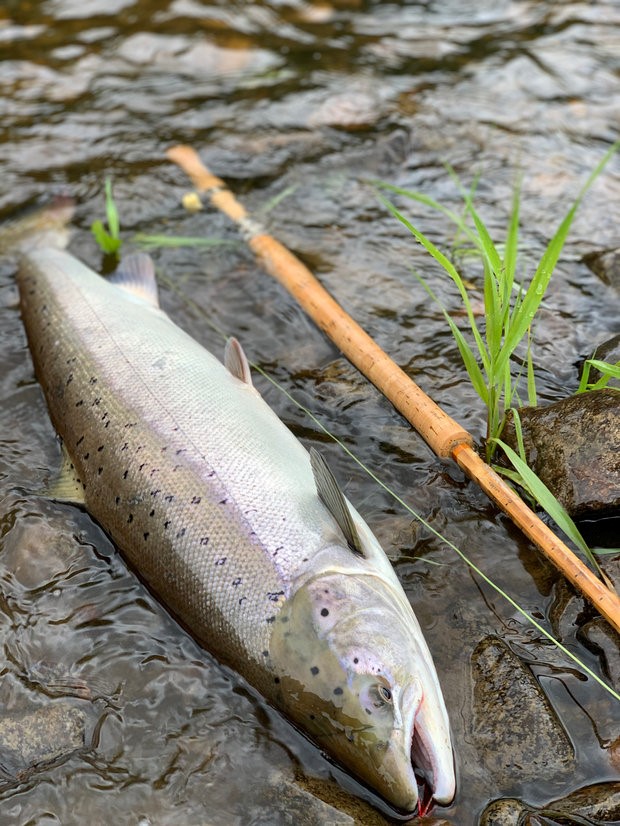
Great springer photo pirated from Ian Gordon who won’t mind since his blog is getting a little free advertising.
Here is the essence of the 145 replies that his question received:
- With 31% Hatcheries were the number one thing that anglers suggest we can do to help.
- With 25% Predator control was the second
- With 20% Control of Aquaculture.
- With 11% Overfishing of salmon food [ making fish meal] at sea.
- With 7% More targeted research into what is happening at sea.
In my view experienced salmon anglers, especially very experienced salmon anglers, are a relatively wise and practical bunch. These anglers know that there are lots of things here on land that are not ideal for the salmon, but most aren’t critical, and in most cases environmental factors are actually better today than they were 40 years ago when salmon were a lot more abundant. These anglers also know that the sea is a big place and the problems that we are having there are very difficult for any person or advocacy group to really do a lot about.
What we can do that would have a very positive and immediate impact, is to give nature a helping hand. Modern hatchery techniques applied on a large scale would really help the Miramichi through these difficult times, and by a large margin the greatest percentage of all respondents picked the direct action of hatchery supplementation to combat the declining populations. Amen.
That is probably it until after I get back from the Naver on March 11, but then I’ll report on that trip and whatever developments there are in the unfolding attempts by the Miramichi salmon community to get some positive responses out of DFO.
Thanks for reading. Brad Burns



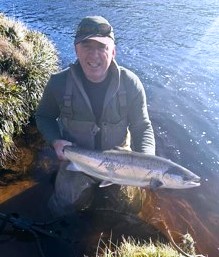
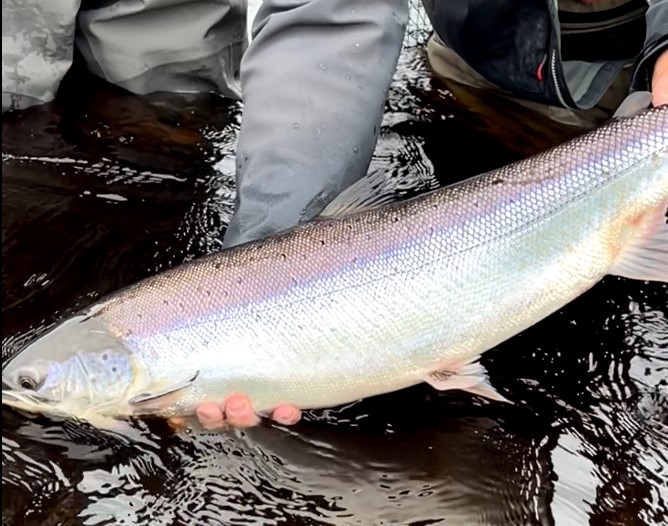
Fantastic blog, as usual. Thank you
Brad great write up usual.
The black Salmon flies you refer to as long wiggly things, where can you buy them.
Was given a couple last year, unfortunately I lost them both.
Hi Brad
A fun read and it gets us starting to check our rod , reels & flies . Tight lines in Scotland
Bryan
Hi Brad,
A 3D F/H/I or H/I/2 is far more effective for springers than a standard sinking tip (floating belly + 15-foot sinking tip). A full-sinking triple-density shooting head keeps the fly at the desired depth throughout the swing as compared to a standard sinking tip, which pulls the fly up through the water column during the swing (due to the full floating belly).
If you were to compare two top salmon anglers fishing for May/June salmon on the Gaspesie or in Norway–one on a 3D line, the other on a standard sinking tip– the angler on the 3D will out-fish the angler on a sinking tip by a factor of 2 or 3. It’s not even close. Sinking tips work. 3D lines just work better.
The wildcard in this scenario is the new category of hybrid lines. Essentially a cross between a 3D shooting head and skagit line, these lines represent the future of fly lines designed for Atlantic salmon fishing, in my opinion. They are deadly. The best hybrid lines on the market at the moment are the Nexcast Zone 2D + tips and the soon to be released Gaelforce Foss 2D + tips. Hybrid lines simultaneously solve the floating belly problem of standard sinking tips AND the interchangeable-tip problem of 3D lines. The Nextcast Zone has been the best-selling line in Norway for three years running.
Best wishes, Topher Browne